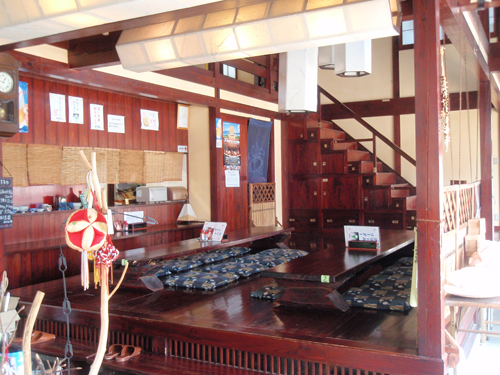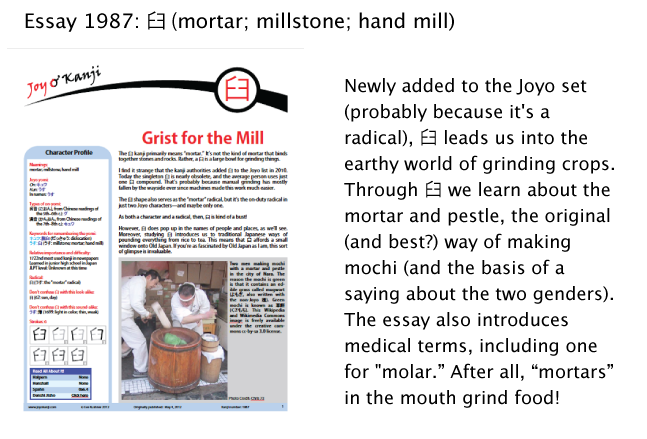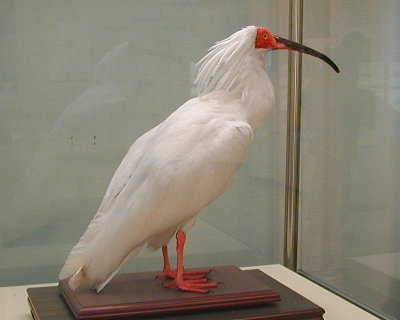Putting the Pieces Together
A quiz of sorts: do you have any idea what the following word might mean?
孵化
Look carefully at the components of 孵! I'll reveal the answer at the end.
There are a zillion ways to lose yourself in the details of one kanji. My life is all about that, and I love it! But there's also something ultra-satisfying about putting all the pieces together and seeing them as a beautiful mosaic. Last weekend I did just that.
My proofreader had sent me a scan of the April 24 Yomiuri Shimbun, because one cartoon featured something relevant to essay 1989 (巾: cloth, towel). I was curious about the cartoon but felt more drawn to an adjacent article about Sado Island, which I briefly visited two summers ago in hopes of finding Old Japan. That short trip to a faraway place let me have a taste of life in a two-hundred-year-old Japanese village, fulfilling my deepest fantasies.

Photo Credit: Eve Kushner
On Sado Island, tiny Shukunegi village had an unexpectedly gorgeous restaurant. It was a very informal place with a tiny menu, but it certainly felt elegant because of the gleaming wood. Sado has a thriving timber industry, and the cedar and pine make for wonderful interiors.
I knew I would need help to understand both the cartoon and the article, so I consulted my language partner, Kensuke-san. For four years we've been Skyping on Saturdays, talking for an hour in Japanese, then an hour in English. Reading the cartoon and article aloud with him proved to be just about as satisfying as the Sado trip.
Whenever I've had the chance to read kanji with a Japanese person at my side (figuratively speaking, in the case of Skype), the experience has been out of this world. I get all my needs met. How much better could life be?!
Kensuke-san and I focused intensely on the article for about 90 minutes. I began by reading it aloud and translating sentences into English. He helped as needed. Then, during the English hour, I continued reading the Japanese, and he translated it into English.
The article wasn't actually about Sado but rather about the toki, the Japanese crested ibis. Once widespread, this bird is now endangered in Japan. Thanks to a restoration program on Sado, some adult tokis have been released into the wild, and they're beginning to reproduce. On April 23, three chicks hatched!

As we went along, I made mistakes. Oh, did I ever! A first-term kanji student would have blushed at some of my mistakes. But that's okay (kind of!) because it shone a light for me on places where I'm fuzzy about the simplest look-alikes and about certain yomi. I won't share examples with you. No need to illuminate too much here!
I was particularly happy to have Kensuke-san there when I ran into this 13-kanji string and flailed:
環境省佐渡自然保護官事務所
I recognized 環境 as a unit, and I know 佐渡 (さど: name of the island), but after that, I took each kanji on its own, voicing the yomi one by one (if at all) and sounding like an elementary school student who has no sense of what she's reading! He calmly broke the string down into meaningful parts:
環境省 (かんきょうしょう: Ministry of the Environment)
環境 (かんきょう: environment)
-省 (-しょう: ministry)
佐渡 (さど: island name)
自然 (しぜん: nature)
保護官 (ほごかん: government official in charge of protection)
保護 (ほごかん: care, protection)
-官 (-かん: suffix for government official)
事務所 (じむしょ: office)
What a relief!
He also let me in on his thinking with this sentence, where I've reddened items of interest:
同事務所の川瀬翼•自然保護官は「3羽とも元気よく首を伸ばして餌をもらっている」と興奮した様子で話した。
I knew 同事務所, where 同- (どう-) means "same," making this "the same office" or "the said office." I then saw a river, 川, but what came after that?! Those three kanji, 川瀬翼, form a name (かわせ つばさ), he told me. This puzzled me more. What indicated such a thing? First, 同事務所の signaled to him that we would be hearing the name of a person in that office. Second, Kensuke-san looked ahead and saw a quotation, followed by 話した (話しました: (s/he) said). Clearly, the comment is attributed to a person.
The hardest sentence for me to understand and for him to translate was a mile long, and a dash added to my muddle:
同事務所では、このペアが孵化に成功した要因について、(1) カラスなどの外敵や人から見えにくい林の中で営巣している (2) 親鳥が共に若く、自然環境への適応力が高かった——ことを挙げている。
I've again reddened the parts relevant to my confusion. As Kensuke-san explained, when you see 要因 (よういん: contributing factor, main cause, primary reason), you know to expect 挙げる (あげる: to give), because they go together as 要因を挙げる (to give a primary reason), even when they're far, far apart!
He eventually ran out of text (as I hadn't sent him the whole scan), and I read him a few more sentences, working hard to make sure he could understand. (He did!) His copy ended with this:
また、抱卵をいったん中
He said the next kanji must be 止. Yes, it was! Actually, the text said 中止した (ちゅうしした: suspended, interrupted). His intuition struck me as miraculous, but he felt that it was no big deal because he took his cue from the preceding words:
また (and)
抱卵 (ほうらん: incubation)
いったん (一旦: for a moment; temporarily), written in hiragana, even though 旦 is a Joyo kanji
Still, I choose to remain impressed!
I've mentioned the things that stumped me, but I was even more excited about the way the text seemed to integrate everything I've ever learned! For example, these two words worked muscles I haven't used since my Kanji 1 class in 2003:
島内 (とうない: on the island)
放鳥 (ほうちょう: bird to be set free)
That is, I had to think about the on-yomi of 島 and 鳥 while looking carefully enough to keep these two kanji straight! (Of course, 島内 and 放鳥 also feature the on-yomi of 内 and 放, but I use those readings much more often.)
The article repeatedly used 雄 (male) and 雌 (female). Although I had recently written about these characters in "Gendered Kanji," I had never memorized their kun-yomi (respectively, おす and めす in this context, although they also have other Joyo kun-yomi). This time I said them over and over until they became second nature.
Oh, I ran into so many other "old friends," including 成功 (せいこう: success), which I wrote about in an essay for a long-ago Japanese class, as well as 環境 (かんきょう: environment), which I blogged about several times in 2008. Coming upon word after word with deep personal significance, I felt as if I were leafing through a photo album filled with happy memories.
Then, too, I felt the thrill of piecing things together unexpectedly, working with the bits I knew and extrapolating as best I could, correctly guessing meanings and yomi. For example, I encountered this word:
抱卵 (ほうらん)
Looking at 抱, I thought of 包む (つつむ: to wrap). I knew 卵 as "egg." To wrap an egg ... Could 抱卵 mean "incubation"? Yes! It just so happens that 抱 has a simple etymology for a change, combining the "hand" radical 扌with "to wrap," producing "to embrace, hold, hug." So incubation is "embracing eggs"!
I could also figure out the meaning of the next two words because I knew the individual kanji, even if I don't recall having seen them together before:
交代 (こうたい: changing places with; alternation; change; shift; substitution)
外敵 (がいてき: foreign enemy)
Can birds have foreign enemies?! Earlier, when telling me about the endangered toki, Kensuke-san had mentioned that Japan had imported these birds from China and Korea to boost their numbers. Perhaps other animals on Sado recognize the innate foreignness of these new arrivals!
Now we come back to my favorite word from the article, the one I quizzed you on at the beginning:
孵化 (ふか)
The first kanji is non-Joyo, and the yomi of the whole is so difficult that the article supplied furigana. Kensuke took one look at this word and seemed to shiver with fear! But it's actually not so scary. Let's take a closer look:
孵
What we have here is 卵 (egg), 爪 (the very "claw" radical I mentioned last week!), and 子 (child). Then we have 化 (to change). Given all these bits of meaning, and given the context, it isn't hard to guess what this word means:
孵化 (ふか: incubation; hatching) to incubate, hatch + to change
Putting the pieces together is indeed a beautiful thing!
I've already gone on long enough (despite having axed effusive paragraph after effusive paragraph about other high points in that talk!!!), but I wanted to let you know about the newest publication. I've just posted essay 1987 on 臼. Here's a sneak preview:

Just in case you're dying of curiosity about the article, I've typed it below. This fragment is as far as we got after 90 minutes (believe it or not)!!! Kensuke-san and I plan to read the rest next week. Sorry—no room here for translations of words or of the whole. Take a crack at it anyway. I also encourage you to prevail upon a native speaker to read it with you! I hope you feel as transported as I did!
*******
きょうだい3羽元気親トキ餌やり大忙し
新潟県の佐渡島で放鳥され、ひな誕生が確認されたトキのペア(3歳雄、2歳雌)に、少なくとも計3羽のひながいることが23日, わかった。ほかにも島内には抱卵中のペアが9組おり、今後、放鳥トキに次々と2世が誕生する可能性がある。
環境省佐渡自然保護官事務所によると、23日撮影したビデオカメラの映像に3羽のひなが同時に映っていた。2羽の体長はやく20 センチ、もう1羽がやや小さいといい、生まれて数日程度とみられる。
親鳥は1時間ごとに交代で餌を探しに出かけている。同事務所の川瀬翼•自然保護官は「3羽とも元気よく首を伸ばして餌をもらっている」と興奮した様子で話した。
3羽のひなの親鳥は3月18日に抱卵が観察され、4月22日に孵化が確認された。同事務所では、このペアが孵化に成功した要因について、(1) カラスなどの外敵や人から見えにくい林の中で営巣している (2) 親鳥が共に若く、自然環境への適応力が高かった——ことを挙げている。
佐渡島内では今春、このペアを含めて15組が営巣。ほかに9組が卵を温めており、6歳雄と7歳雌のペアの卵が19日に孵化予定日に入った。
また、抱卵をいったん中止した6歳雄と4歳雌のペアが18日2度目の抱卵に入っている。


Comments